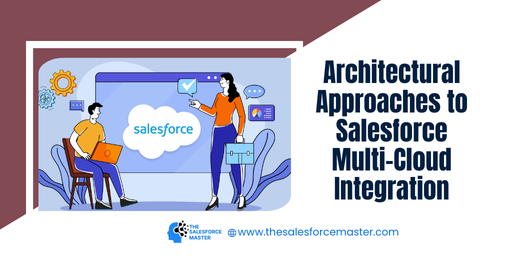
Architectural Approaches to Salesforce Multi-Cloud Integration
Integrating Salesforce’s multi-cloud solutions can transform business operations. A unified approach across Sales Cloud, Service Cloud, Marketing Cloud, and other Salesforce offerings enhances efficiency, data flow, and customer experiences. This article delves into key architectural approaches to achieve seamless multi-cloud integration in Salesforce environments.
Leveraging API-First Architecture
One fundamental approach to multi-cloud integration is leveraging an API-first architecture. Salesforce provides robust APIs that enable communication between different clouds and third-party systems. By designing integrations with APIs from the start, developers can ensure scalability, flexibility, and consistency.
Advantages of API-First Architecture
- Standardization: APIs provide a standard interface for data exchange, reducing inconsistencies.
- Reusability: Once developed, APIs can be reused across various projects and integrations.
- Flexibility: API-driven integrations are adaptable to changes in business processes or systems.
Using APIs effectively can help architects manage data across Salesforce clouds, streamline workflows, and improve system interoperability. This approach is crucial for organizations seeking to build a scalable and maintainable integration framework.
Implementing Event-Driven Integration
Event-driven integration is another powerful strategy for Salesforce multi-cloud environments. By utilizing Salesforce’s Platform Events, organizations can create reactive systems that respond to changes in real time. This method allows for more efficient and timely data synchronization and processing.
Benefits of Event-Driven Integration
- Real-Time Processing: Immediate response to events ensures up-to-date information across systems.
- Decoupling Systems: Events allow systems to operate independently, enhancing scalability and reliability.
- Reduced Latency: Faster data propagation between clouds minimizes delays and improves user experience.
Implementing event-driven architecture involves setting up listeners and publishers for relevant events, ensuring that all connected systems can react appropriately. This approach can lead to significant improvements in operational efficiency and data accuracy.
Utilizing Middleware for Seamless Connectivity
Middleware solutions play a critical role in multi-cloud integration by acting as intermediaries that manage data flow between different systems. Tools like MuleSoft, a part of Salesforce, provide a comprehensive platform for connecting various Salesforce clouds and external applications.
- Centralized Integration Management: Middleware offers a single point of control for all integrations.
- Enhanced Data Transformation: It allows for complex data transformations, ensuring compatibility between systems.
- Improved Monitoring and Troubleshooting: Middleware provides tools for monitoring integrations and diagnosing issues quickly.
By utilizing middleware, organizations can simplify the integration process, reduce development time, and ensure robust and secure data exchange between Salesforce clouds. This approach is particularly beneficial for complex integration scenarios involving multiple systems and large data volumes.
Conclusion
Integrating Salesforce’s multi-cloud solutions requires strategic architectural approaches to ensure seamless data flow, scalability, and efficiency. Leveraging API-first architecture, implementing event-driven integration, and utilizing middleware are essential strategies for achieving successful multi-cloud integration. By adopting these practices, organizations can enhance their operational capabilities, deliver superior customer experiences, and maximize the value of their Salesforce investments.
Incorporating these architectural approaches into your Salesforce multi-cloud strategy can significantly impact your business outcomes, driving innovation and growth in a competitive landscape.

